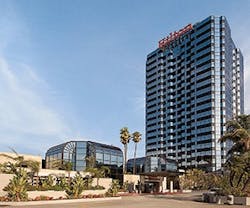LA Project Is Largest to Use PACE Financing
Using PACE (Property-Assessed Clean Energy) funds, the Hilton Los Angeles/Universal City has financed 100% of the $7 million cost of a range of building improvements, making it the largest PACE project to date in the U.S.
The PACE financing concept for efficiency improvements relies on an assessment made to the building owner’s property tax bill, much like any other municipal tax assessment. The assessment provides collateral for the debt, thus avoiding the kind of large upfront payment necessary for conventional financing. The assessment is transferred to any subsequent owner via the property tax. The current building owner and any future owner profit from lower utility bills made possible by the energy equipment upgrade.
Improvements at the Hilton, which opened in 1984, include LED lighting, low-flow water fixtures, window and elevator upgrades, and fans and chillers (see box). Annual energy and water savings in Year 1 are estimated at $800,000.
Structured Finance Associates, LLC arranged PACE financing for the Hilton. According to managing director L. Jean Dunn, Jr., the benefits of PACE include a fixed rate, little or no upfront, out-of-pocket expenses, and a long repayment term – in this case, 20 years. As a result, many PACE projects enjoy positive cash flow from the outset.
Another advantage of PACE financing is in the eyes of a lender. “A banker tends to think about the worst possibility, which is that the building owner defaults by not paying his property tax,” Dunn explains.
With a conventional loan, default causes the full outstanding amount of a loan to come due immediately, plus penalties and interest. But in the case of PACE financing, only the annual assessment is due immediately in the year of a default; each portion of the assessment can only be levied in one-year increments on the property tax bill.
Steve Thompson, director of property operations at the hotel, said that the low cost of the financing allowed the project’s scope to grow beyond the initial plan. If he had it to do over, the only change he would make is start the project earlier, Thompson says.
The Los Angeles County PACE Program is available to commercial, industrial, and multifamily property owners seeking to fund on-site renewable energy projects as well as water and energy improvements. Financing is repaid twice a year through the assessment on property taxes. Owners can choose their own PACE financier and negotiate their rate and terms.
To enact PACE programs, states must pass “enabling” legislation that authorizes municipalities to place assessments as the means of repaying funds for energy efficiency or renewable energy. To date, 31 states have enabled such legislation but not all of them yet have working PACE programs. (For information on PACE programs that may be operating in your area, visit www.PACENow.org.)
